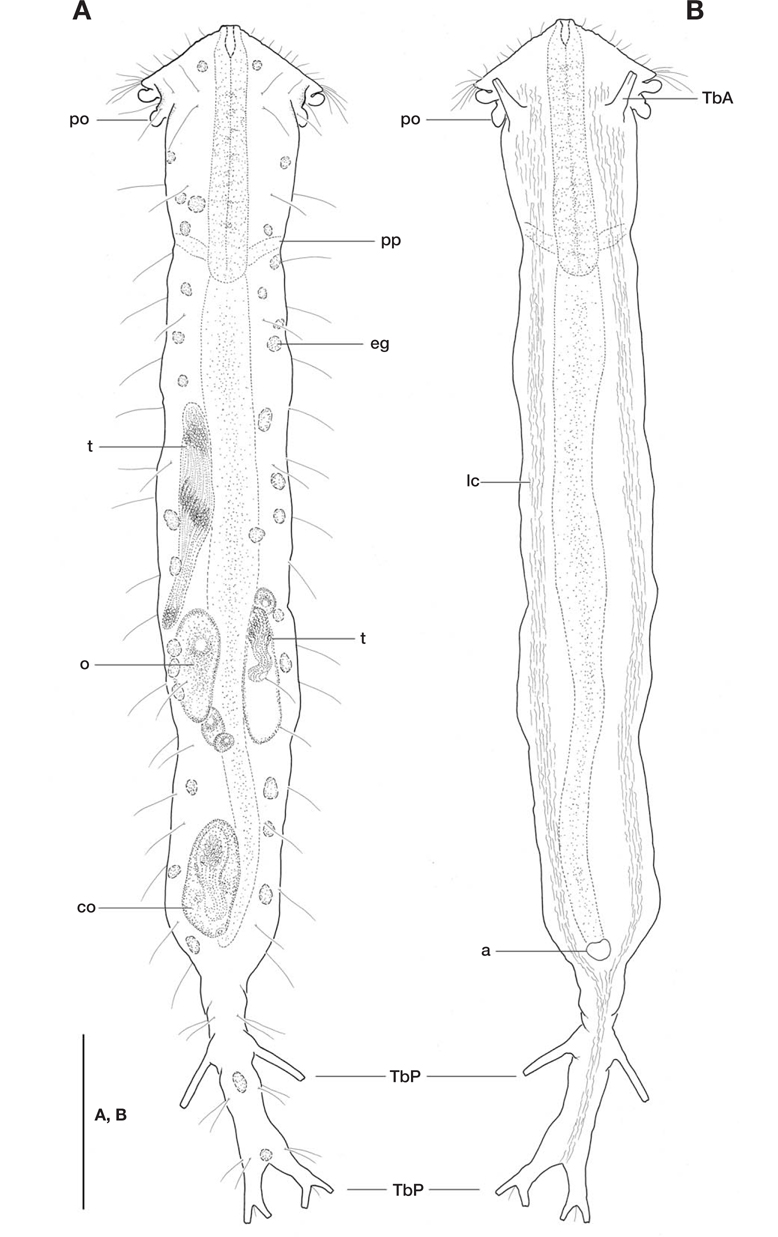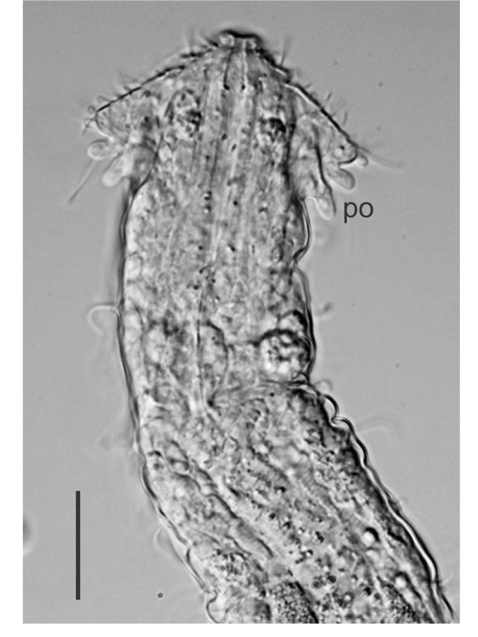



Dactylopodolid gastrotrichs have been considered the most basal group within macrodasyid gastrotrichs, because they show the characteristic combination of having cross-striated body muscles and monociliated epidermal cells ventrally (Hummon, 1982; Hochberg and Litvaitis, 2001). Among three genera of the family Dactylopodolidae currently recognized, the genus
In the genus
Recently we discovered a new species from sublittoral fine sandy bottoms of Uljin and Jeju Island, South Korea. This is the first record of
Specimens were collected from shallow sublittoral fine sandy bottoms, at about 1-2m in water depth at Gujwa, the northeastern coast of Jeju Island, and at about 5-6 m deep at Uljin, the east coast of Korea (East Sea or Sea of Japan).
Fine sands were taken by scooping the surface sediments of several centimeters using a long-handled bowl at Gujwa, and using the Smith-Mclntyre grab at Uljin. Samples were extracted through a 63 μm mesh sieve after performing the anesthetization-decantation method with 7% MgCl2 for 5-10 min, and were fixed in 4% buffered formalin. Living specimens from Uljin were video-captured using a CCD camera (eXcope X3; DIXI Optics Co., Daejeon, Korea). Methods of sample preparation, observation, and measurements follow those of our previous papers (Lee and Chang, 2003; Lee et al., 2009).
Type specimens have been deposited at the National Institute of Biological Resources (NIBR), Incheon, Korea and the Korea Institute of Ocean Science & Technology (KIOST), Ansan, Korea.
Terminology mostly followed that of Hummon et al. (1992) and Clausen (2000). Abbreviations used in the text are as follows: Lt, total length, from anterior tip of head to posterior tip of pedicles including adhesive tubes; PhJIn, junction between pharynx and intestine; TbA, anterior adhesive tubes; TbD, dorsal adhesive tubes; TbL, lateral adhesive tubes; TbP, posterior adhesive tubes; U, percentage unit of Lt, used for the location (U-) from anterior to posterior, or for the relative length (-U).
Order Macrodasyida Remane, 1925 [Rao & Clausen, 1970] 1*Family Dactylopodolidae Strand, 1929 2*Genus Dendrodasys Wilke, 1954
Type locality. Korea: Jeju Island, Jongdal-ri, Gujwa, 33° 29′ 12′′N, 126° 54′36′′E; 2-3m depth.
Type material. Holotype (NIBRIV0000279613) and 11 paratypes (KIOSTG0401-0409, NIBRIV0000279614, NIBRIV 0000279615) mounted in glycerin on H-S slides, 23 Apr 2006,
Additional material examined: Korea: Two individuals, Uljin, Hupo, 36° 40′51′′N, 129° 28′08′′E; 5-6 m depth, 27 Aug 2013,
Etymology. The proposed specific name,
Diagnosis. A slender
Description of holotype. Body slender, Lt 345 μm; broadest at level of lateral lobes of head, and slightly constricted at pharyngeal pores; both lateral sides of trunk nearly parallel, before tapering into long pedunculate caudum; caudum narrow, well defined, 70 μm long (20U), about one-fifth of body length, bifurcated distally at U95. Widths of head/neck/PhJIn/ trunk/caudal base 52/30/33/38/15 μm at U05/U18/U21/ U44/U79 respectively.
Head triangular, with mouth slightly protruding anteriorly; armed with 8-9 cephalic sensory hairs along anterior margin. Lateral lobes small, triangular with a ciliary tuft apically, consisting of 4-5 cilia. Two pairs of pestle organs emerging between lateral lobes and TbA, each pair of pestle organs separate, not confluent at base; fore one issuing beneath lateral lobe at U06, rear one arising dorsally, split from basis of lateral lobe at U08. Sensory hairs, two per side implanted on dorsolateral side near rear pestle organ; about 9-10 dorsolateral hairs and 13-14 lateral hairs per side aligned, evenly spaced between anterior pharyngeal region and caudal peduncle (U06-U78); three paired hairs per side situated along lateral margin of caudal peduncle at regular intervals.
Epidermal glands small, generally circular or ovoid, ~6 μm in diameter; foremost one located mid-dorsally near anterior pharyngeal region at U03; 15 glands per side, aligned asymmetrically along lateral side from anterior pharyngeal region to caudal base at U10-U77; two glands located on caudal peduncle, anterior one placed slightly behind TbP at U87, posterior one near bifurcated base of caudum at U94.
Adhesive tubes: TbA, one per side, 13 μm long, with enlarged base, occurring slightly behind pestle organs, at U07. TbD, TbL and TbV absent. TbP, three per side, consisting of a large tube, 17 μm long, arising from anterior third of lateral margin of caudal peduncle at U85 and two short ones, 6 μm long, forming bifurcate caudum with a bristle between them.
Ventral locomotor cilia showing paired longitudinal bands from front of TbA to caudal base at U05-U78, joining into a narrow column behind anus at U79, extending to bifurcated caudum at U95.
Digestive tract: mouth terminal, small, 3 μm wide; buccal cavity small, U-shaped, somewhat cuticularized; pharynx 72 μm long with pharyngeal pores opened at its posterior end (U18); PhJIn at U21; intestine straight anteriorly, narrowing and slightly curved toward posterior end; anus opened at U76.
Reproductive system: simultaneous hermaphrodite; paired testes asymmetrical, left testis longer than right one, in dorsal view; left testis reaching to anterior intestinal region at U31, and right one to mid-intestinal region at U48; one large ovum located at U48-U56 on left side in dorsal view, following two small oocytes; another small oocyte in front of right testis at U47; copulatory organ ellipsoidal, located at posterior trunk region.
Remarks. In the genus
The five congeneric species can be divided into two groups, depending on the presence or absence of pestle organs. With the pestle organs present, the new species is more closely related to
Aside from the absence of pestle organs,

